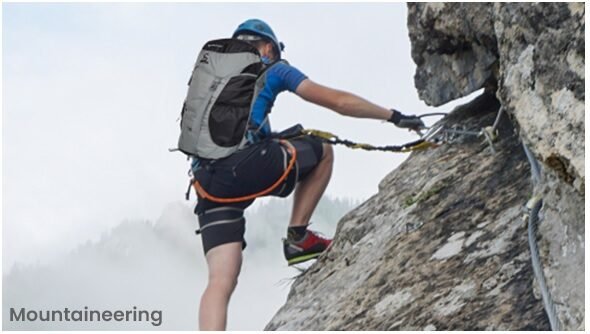Categories Mountaineering February 17, 2023
How to Choose a Winter Mountaineering Pack?
Over the years packs have replaced my desire to buy purses. These things happen when you’re outside all of the time. When you first start out with gear, you make things work, but as your outdoor prowess grows, your need for specialized gear takes over. At first, I would resist, claiming I’d never be that person, but nowadays I know better. You want the right tool for the job. Choosing a pack for winter mountaineering is no different.
What Kind of Winter Mountaineering?
Your needs for a pack are highly dependent on what you are doing. This is tricky because when you start out winter mountaineering chances are you are going to be using ropes, placing pro (protection like snow pickets, snow fences, ice screws, etc), or going on multi-day epics. That simply is realistic because, unlike travel in summer, winter travel takes much more strength, skill, knowledge, and practice. But if you don’t want to buy something you’ll likely outgrow either. Ask yourself the following questions before you make your decision;
- Am I going to be traveling on skis or a split board? If yes then you are going to want a winter touring-specific pack. You can use either of the three spacious Rucksack Bags of 40 to 50 Ltr; Tritus 40 Ltr Rucksack (comes with additional features like; Bungee Cord, Hood pocket, Compression Straps, Wireframe Structure, Emergency Whistle, Waist Belt & Reflective Tape ), Globo 45 Ltr Rucksack (A Front Easy Access Pocket and rest same as above), Axido 50 Ltr Rucksack (A Daisy Chain to Latch small Accessories, rest same as above).
- Will I predominantly be ice climbing? If so then rope, double axe, and pro carry will be something you will want to consider. You also want to have a bag that isn’t going to be too bulky in order to keep your center of gravity normal on a climbing route. The above-mentioned Rucksack Bags would work perfectly fine for this type of requirement as well.
- But I want something that will do it all! Well, I hate to break it to you, but that’s a Quad Backpack 42Ltr with 3 Compartments. If you don’t know what you are getting into or where you want to end up, choose this generic winter pack or basic backcountry touring pack that will sustain you while you learn to travel on snow, then pick up specialized packs later.
Winter Pack Capacity
When selecting your winter pack, you need to keep in mind the gear you will be carrying. Chances are you may have a lot of extra gear such as crampons, ice axe, climbing harnesses, helmets, trekking poles, snowshoes, shovels, probes, and even approach shoes. Not to mention you will likely be carrying several extra layers that you don’t carry in summer.
As you know, I’m a huge proponent of safety in the mountains. In winter, the chances of something going wrong and being stuck in inclement weather are much higher, so I take more gear and come prepared. If I’m out for a really long day, I may even bring a stove so I can melt snow for water.
My winter pack is a Torpedo 35 Ltr Backpack and my boyfriend uses the Cria 45 Ltr Rucksack. Both packs are designed for backcountry touring, but we use them throughout the year. At a minimum, I’d recommend at least carrying a 32L pack. This will give you ample room for a day out in winter.
Winter Mountaineering Pack Features
There are several different features worth considering when choosing a Winter Mountaineering Pack. Keep in mind when you are in a couloir or a steep snow slope, the last thing you want to do is take off your pack and dig through your bag. So, having a few extra bells and whistles will help out tremendously. You can find this feature in our Mountaineering Specialised Rucksack Bags; Tritus, Globo & Axido!
Ice Axe Loops
This is a standard feature on most packs, even on tiny 18L Backpacks. However, if you plan on using multiple tools, double ice axe loops are handy. You can always carry two with one loop, but make sure the loop will fit two axes before committing to this. Luckily, this is an essential feature of our most popular Rucksack Bags.
Winter packs should be versatile. Backcountry skiing requires an entirely different set of features than a simple day pack. (Our Good to Go Day Packs include a Torpedo & Vignette Backpack).
Waterproof storage
This is an area where backcountry Touring Packs excel. Being out in the snow and ice all day can make things sopping wet. The last thing you want is soaking your extra layers in balls of melting ice. Our Torpedo, Cria, Quad, Vignette, Tritus, Globo & Axido packs come with dedicated wet or waterproof storage.
Ski/Board/and Snowshoe carry
If you plan on alpine touring, or even using cross-country skis for your approach, make sure your bag can carry them. Sure, you could stash your skis, but then you can’t ski down. And let’s face it, that’s half the fun! If you do plan on backcountry skiing, always wear a beacon and carry a shovel and probe INSIDE your pack.
NEVER strap avalanche safety gear to the outside of your pack. It can fall and then you’re screwed if you have to perform an avalanche rescue. You must go for our Rucksack Bags for such purposes.
Rucksack Bags have special pouches (usually waterproof) for avalanche safety gear as well as skins. As a bonus, you can also stash your crampons in the dedicated wet pouch too. The benefit of having a ski/snowboard carry system is that it can easily be rigged to carry your snowshoes, trekking poles, or even a rope.
Hip pockets and Gear Loops
Although it can be tedious and unsafe to have gear swinging around to and fro while climbing a mountain, it’s always nice to have a few gear loops just in case. A hip pocket is an excellent place to stash a snack, gloves, or your phone for that alpenglow, photo-worthy moment. Being a definite feature in all our Rucksack bags, you will never need to worry about extra pockets in your Greenlands Travel Gear.
Helmet carry
Once I was out with the Colorado Mountain Club learning snow climbing techniques. I arrived with my touring pack in tow ready for a day of self-arrests, glissades, and front pointing. Everyone immediately oh-ed and awed at the helmet carry feature on my Greenlands Rucksack Bag. It’s an essential item if you plan on backcountry touring, and a great bonus if you climb couloirs or ice. It keeps your helmet from bouncing around and throwing you off balance.
Nothing quite says alpenglow like a pee rag basking in the morning light.
Rope and pro carry
This is where larger packs with a top, or brain, excel. You can stash your rope between the pack’s main body and the brain for easy, secure rope carry. Once again, a must-feature you’ll find in all our Rucksack backpacks. Rope carry with a touring bag is a bit of a pain, as it usually needs to be stashed in one of the ski or board carry options, which isn’t always ideal.
Hydration Bladder Insulation or Easy Water Bottle Access
Hydration pack insulation is an important feature on any piece of Mountaineering Travel gear. They are easy to use and a great help. Also, you must make sure your pack has an easy-grab water bottle pouch or holster.
Durability
One of the number one features to look for with a winter mountaineering pack is durability over weight. Pack weight, although essential in the ultra-light world, comes second to durability in winter mountaineering. Your pack will undergo a beating. Between an axe, crampons, shovel, snowshoe teeth, and skis there are plenty of winter items that will poke and prod your pack. Make sure your pack has extra reinforcement and is built of durable material. It’s well worth the extra weight and cash. Always go for our Mountaineering Specialized Backpacks with all the essential features required for the most comfortable travel experience.
How to Fit a Backpack?
We all know comfort is king so it’s essential your pack fits correctly. If at all possible, get professionally fitted at our outdoor store. However, if that isn’t an option for you, you can easily figure out your size by reading the specs on the website. Packs are sized based on torso height, so your size may surprise you. Essentially, you want to make sure the pack conforms to your back and there isn’t a gap between the shoulder straps and your pack. Basically, a 40 Ltr Backpack works perfectly for a 5.3 feet height person and a 45-50 Ltr Backpack goes with 5.8 feet to 6 feet person. Also, do remember to keep heavy items closest to you, towards the middle of your pack, instead of smashed on the top.
What do I Use for a Winter Mountaineering Pack?
I have two packs that I use for winter mountaineering. My go-to pack is my Tritus 40 Ltr Rucksack. It’s a backcountry touring-specific pack that works fantastically for a single-day summit. When I first got the pack, I didn’t really care for it. Over time, my pack has grown on me and I love it. In fact, I use it for summer mountaineering too. While I was in Nepal, I used the Torpedo 35 Ltr Backpack and loved it as well.
I love using backcountry touring packs for winter outings. They have fantastic features that are specifically designed to make snow travel more comfortable. My touring pack gets the most use out of all of my packs. They are durable and virtually indestructible, making the added weight and cost worth it.
Multi-Day Mountaineering Trip Pack
For longer epics and multi-days I rely on my Axido 50 Ltr Rucksack. The Axido also doubles as my backpacking pack. Axido’s Zero-Gravity hip belt system makes it feel as if I’m carrying a (heavier) feather when I’ve got 40 lbs on my back. It takes a minute to properly weigh and adjust the pack, but once adjusted, it works like a charm. This pack is great if I’m backpacking to a snow climb, or carrying a ton of pro.
Overall, I would look into a basic backcountry touring pack for your first winter mountaineering daypack. Make sure it’s a good fit and you’ll be all set for an epic day in the snow, no matter what your winter activity is.
Ok, That is all for now…
If you enjoyed this article please, Share and Like our Facebook Page. Thanks.



